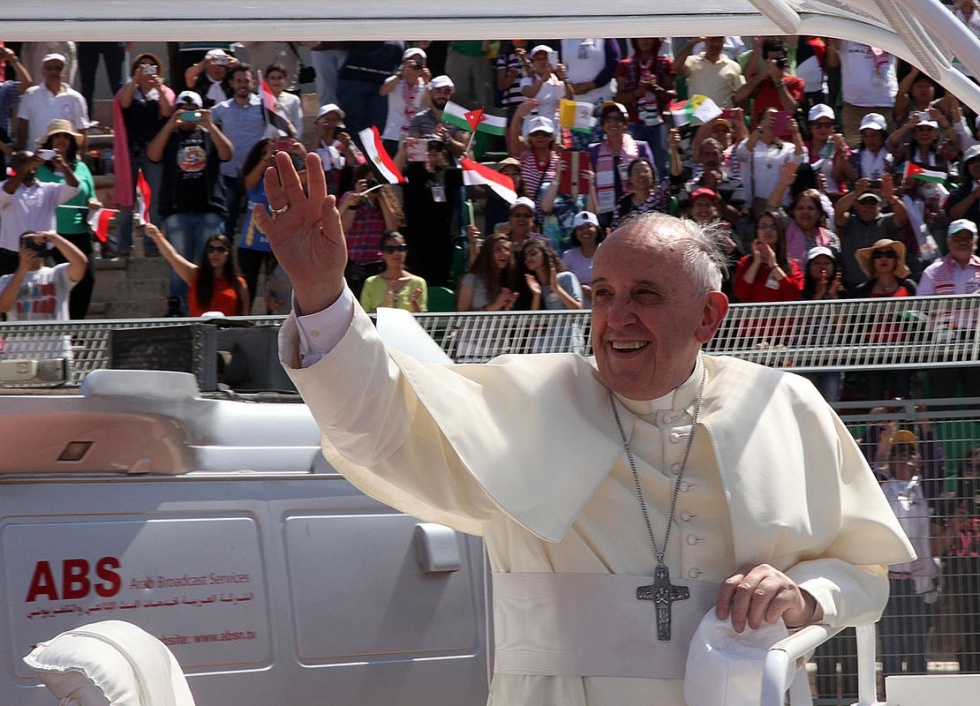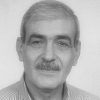Pope’s mission impossible in the Holy Land

Pope Francis’s “pilgrimage” to the Holy Land last week proved to be an unbalanced impossible mission. The pontiff failed to strike a balance of neutrality between contradictory and irreconcilable binaries like good and evil, divinity and earth, religion and politics, justice and injustice and military occupation and peace.
Such neutrality is viewed by the laity of Christian believers in the Holy Land, let alone Muslim ones, as religiously, morally and politically unacceptable.
On 24 May, Naim Ateek, the Anglican priest who founded the Palestinian liberation theology movement and runs the Sabeel Ecumenical Centre in Jerusalem and Nazareth, was quoted by Time magazine as saying that the 77-year-old head of the world’s 1.2 billion Catholics “is stepping into a religious and political minefield”.
Faith diplomacy?
Indeed, the pope’s subservient adaptation to the realpolitik of the Holy Land was described by Catholic Online as “faith diplomacy”. However, the pontiff’s message to the Palestinian people during his three-day “pilgrimage” to the Holy Land can be simply interpreted as an endorsement of the Israeli and US message to them, ie: the only route to peace is to negotiate with the Israeli occupying power, refrain from unilateral actions and “violent” resistance, and recognise Israel as a fait accompli.
The Vatican and the pope himself had insisted that his visit to the birthplace of the three monotheistic “Abrahamic faiths” of Islam, Christianity and Judaism was “purely spiritual”, “strictly religious”, a “pilgrimage for prayer” and “absolutely not political”.
But the Vatican expert John Allen, writing in the Boston Globe a week ahead of the pope’s visit, had expected it to be a “political high-wire act” and according to Yolande Knell on BBC online that’s what it truly was, because “religion and politics cannot be separated in the Holy Land”.
Pope Francis would have performed much better had he adhered “strictly”, “purely” and “absolutely” to making his trip a “pilgrimage for prayer”, and one that is committed to Christian unity and to helping indigenous Christians survive the highly volatile and violent regional environment.
Instead he had drowned his spiritual role in a minefield of symbolic political semantics and semiotics.
The pope finished his “pilgrimage”, which was announced as a religious one but turned instead into a political one, with a call for peace.
However, the Grand Mufti of Jerusalem, Muhammad Hussein, while welcoming the pontiff inside Islam’s third holiest site of al-Aqsa Mosque on 26 May, said: “Peace in this land will not happen until the end of the [Israeli military] occupation.”
On 25 May, Palestinian-American Daoud Kuttab wrote in a controversial column that the pope “exceeded expectations for Palestinians”. He flew directly from Jordan to Bethlehem in Palestine without passing through any Israeli entry procedures, implicitly and symbolically recognising Palestinian sovereignty.
He addressed the Palestinian President Mahmoud Abbas as the head of the “state of Palestine”; announced that there must be “recognition of the right of the Palestinian people to a sovereign homeland, and acknowledged their right to live with dignity and with freedom of movement”; met with Palestinian children whose parents were refugees whom Israelis displaced from their homes in 1948.
Furthermore, in an undeniable expression of solidarity with the Palestinians, he made an unplanned stop to pray at Israel’s segregation wall in Bethlehem, because, as he said, “the time has come to put an end to this situation which has become increasingly unacceptable”. However, the word “occupation” was missing in more than thirteen of his speeches during his “pilgrimage”.
Eight papal messages
However, less than 24 hours later, the pontiff was to offset his positive overtures to Palestinians with eight messages to them.
The pontiff’s arrival in the Holy Land came three days before Israel’s celebration of its 47th anniversary of its military occupation and annexation of the Christian and Muslim holy sites in Arab East Jerusalem and 10 days after the Palestinian commemoration of the 66th anniversary of their Nakba.
The pope had nothing to say or do on both occasions to alleviate the ensuing plight of the Palestinians except offer prayers, because he maintained aboard his flight back to Rome, “the concrete measures for peace must come from negotiations … It is the only route to peace”.
That was exactly the same futile message the Israeli occupying power and its US strategic ally have been sending Palestinians for 66 years, but especially since 1967: Palestinians should be held hostages to exclusively bilateral negotiations with their occupying power. This was the pope’s first message to Palestinians.
For this purpose, the pope invited Palestinian and Israeli presidents, Abbas and Shimon Peres, to pray for peace at “my home in the Vatican as a place for this encounter of prayer” on 8 June. The pope's spokesman, Federico Lombardi, told the BBC it was “a papal peace initiative”. This was his second message.
His third message to Palestinians was to “refrain from initiatives and actions which contradict the stated desire to reach a true agreement” with Israel, ie to refrain from unilateral actions, which is again another Israeli and US precondition which both allies do not deem as deserving of Israeli reciprocity.
By laying a wreath at the grave of Theodor Herzl, the atheist founder of Zionism who nonetheless believed in God’s promise of the land to his Jewish “chosen people”, the pope legitimised Herzl’s colonial settlement project in Palestine. This was his fourth message: Israel is a fait accompli recognised by the Vatican and Palestinians have to adapt accordingly. The Washington Post went further, describing the act as: “Some are interpreting” it “as the pontiff’s tacit recognition of the country’s Jewish character”.
The pope sent his fifth message to Palestinians when he addressed young Palestinian refugees from the Dehiyshe Refugee Camp in Bethlehem: “Don't ever allow the past to determine your life, always look forward.” He was repeating the Israeli and US call on Palestinian refugees to forget their Nakba and look forward to an unknown future in exile and diaspora.
On the same occasion he sent his sixth message: “Violence cannot be defeated by violence; violence can only be defeated with peace,” the pope advised the young Palestinian refugees. This is again the same as the Israeli and US message, which, after more than two decades of Palestinian commitment, has produced neither peace nor justice.
The pope prayed at the Holocaust memorial; the western al-Buraq Wall of al-Aqsa Mosque, which Israelis call “the Wailing Wall”, the memorial of the Israeli victims of Palestinian resistance; laid a wreath at Herzl’s grave; visited the Israeli president at his residence, where he “vowed to pray for the institutions of the state of Israel”; and received Israeli Prime Minister Binyamin Netanyahu at the Notre Dame complex. By doing this, the pontiff was in fact blessing and granting Vatican legitimacy to all the Israeli symbolic casus belli claims to the land, which justify the Palestinian Nakba. This was his seventh message.
All those events took place in Jerusalem, which Israel annexed as the “eternal” capital of the Hebrew state and the “Jewish people”. Reuven Berko, writing in Israel Hayom, said that the Pope's meetings with Peres and Netanyahu were “de facto expressions of the Vatican's recognition of Jerusalem as capital of Israel”.
The pope’s eighth message to Palestinians was on the future of Jerusalem: “From the negotiations perhaps it will emerge that it will be the capital of one state or another … I do not consider myself competent to say that we should do one thing or another.”
The “greatest importance” of the pope’s visit “may lie in the fact that it reflects the normalisation of relations between the Vatican and the State of Israel”, wrote Abraham Foxman, head of the Anti-Defamation League. Rabbi David Rosen, director of inter-religious affairs at the American Jewish Committee, was quoted in USA Today as saying, that there “has been a revolution in the Christian world”.
At Ben-Gurion airport on 25 May, Pope Francis reiterated his predecessor Benedict’s call for “the right of existence for the [still borderless] state of Israel to be recognised universally,” but was wise enough not to reiterate his “thanks to God” because “the Jews returned to the lands of their ancestors”.
- Nicola Nasser is a veteran Arab journalist based in Birzeit, West Bank of the Israeli-occupied Palestinian territories.
The views expressed in this article belong to the author and do not necessarily reflect the editorial policy of Middle East Eye.
Photo credit: Pope Francis greets spectators during his three-day Middle East tour (Anadolu Agency)
Middle East Eye propose une couverture et une analyse indépendantes et incomparables du Moyen-Orient, de l’Afrique du Nord et d’autres régions du monde. Pour en savoir plus sur la reprise de ce contenu et les frais qui s’appliquent, veuillez remplir ce formulaire [en anglais]. Pour en savoir plus sur MEE, cliquez ici [en anglais].


